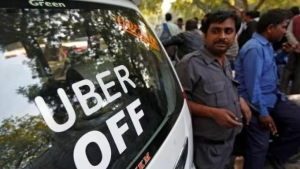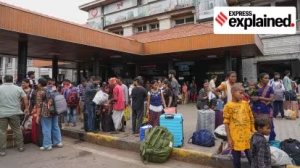The Mumbai drivers’ strike has brought the city’s transportation system to a standstill as thousands of app-based cab drivers from Ola, Uber, and Rapido continue their indefinite protest. Commuters in Mumbai faced yet another day of hardship as the indefinite strike by app-based cab drivers of Ola, Uber, and Rapido entered its fourth consecutive day on Friday, July 18. The ongoing agitation has severely impacted daily commutes across the Mumbai Metropolitan Region, forcing residents to seek alternative transportation methods.
On July 15, 2025, thousands of auto-rickshaw drivers, cabbies and gig workers from across Maharashtra gathered at Azad Maidan, Mumbai, to protest the alleged inaction of the transport department and demand stronger protection and regulation for platform-based workers. The Mumbai drivers’ strike has gained momentum with each passing day, as frustrated drivers unite to voice their grievances against unfair working conditions and reduced earnings.

Also read and watch: Why are Ola Uber Drivers on Strike in Mumbai?
The epicentre of the Mumbai drivers’ strike remains Azad Maidan, where the protest is expected to intensify at Azad Maidan with a massive rally planned for Friday. This historic protest ground has become the focal point for driver demonstrations, with participants demanding immediate action from transportation authorities and ride-hailing companies.
Hundreds of drivers for app-based ride-hailing platforms like Ola, Uber, and Rapido gathered at Azad Maidan on Tuesday to demand the enforcement of the aggregator policy and wage parity with traditional kaali-peeli taxi drivers. The Mumbai drivers’ strike has been organised by various driver unions, including the Indian Federation of App-based Transport Workers, who have been instrumental in coordinating the protest activities.
The demonstration at Azad Maidan represents more than just a local grievance; it symbolises the broader struggle of gig economy workers across India seeking fair treatment and adequate compensation for their services.
The Mumbai drivers’ strike centres around several critical issues that have plagued app-based drivers for months. Primary among these concerns is the demand for fare rationalisation and reduced commission structures imposed by ride-hailing platforms. Drivers argue that current commission rates, often exceeding 20-25%, leave them with insufficient earnings to sustain their livelihoods.
Another significant demand involves the implementation of fixed fare structures that would provide drivers with predictable income streams. The Mumbai drivers’ strike has highlighted how surge pricing benefits primarily the platforms while drivers bear the brunt of customer dissatisfaction during peak hours.
Additionally, protesters are calling for enhanced social security measures, including health insurance coverage and accident compensation schemes. The absence of traditional employment benefits has made app-based drivers particularly vulnerable to economic uncertainties, a concern that has been amplified during the Mumbai drivers’ strike.

The Mumbai drivers’ strike has created unprecedented challenges for millions of daily commuters across the city. Transportation options to and from Mumbai Airport may be disrupted today. Passengers are encouraged to check the availability of transport services beforehand and make alternate travel arrangements if necessary. The strike has particularly affected airport connectivity, forcing travellers to rely on limited public transportation options.
Office-goers, students, and emergency service users have been the most affected by the Mumbai drivers’ strike. Many commuters report waiting hours for available rides, with those that are operational charging premium rates due to increased demand. The situation has prompted many to explore alternative transportation methods, including increased usage of Mumbai’s local train network and traditional taxi services.
Business districts across Mumbai have witnessed reduced foot traffic as employees struggle to reach their workplaces. The Mumbai drivers’ strike has also impacted the city’s tourism industry, with visitors finding it challenging to navigate the metropolitan area without reliable app-based transportation services.
Beyond commuter inconvenience, the strike has raised safety concerns, with reports of striking drivers confronting those who continue to operate during the protest. A video surfaced online showing a non-participating Ola-Uber driver operating a private vehicle with a government sticker on the car, highlighting tensions between striking and non-striking drivers.
The Mumbai drivers’ strike has witnessed several incidents where protesters have attempted to prevent other drivers from accepting rides through the applications. While most demonstrations have remained peaceful, isolated incidents of vehicle blocking and confrontational behaviour have been reported across the city.
Authorities have increased police presence in key areas to maintain order and ensure that the Mumbai drivers’ strike does not escalate into violence. The Maharashtra government has urged all parties to sustain peaceful protest methods while working toward a resolution.
Major ride-hailing platforms have acknowledged the ongoing Mumbai drivers’ strike and its impact on service availability. Drivers demand fixed fares and lower commissions as the strike affects bookings on Uber and Ola, while Rapido and Kali-peeli cabs continue partial operations in the city. The platforms have reportedly been in discussions with driver representatives to address key concerns.


The Maharashtra state government has taken note of the Mumbai drivers’ strike and has initiated dialogue with both driver unions and platform representatives. Transport department officials have scheduled meetings to discuss the implementation of aggregator policies that could address driver concerns while maintaining service quality for consumers.
Industry experts suggest that the Mumbai drivers’ strike could catalyse comprehensive policy reforms in the gig economy sector. Proposed solutions include the establishment of minimum fare guarantees, reduced commission caps, and the creation of social security frameworks specifically designed for app-based workers.
The Mumbai drivers’ strike represents a pivotal moment in the evolution of India’s gig economy landscape. As the protest continues at Azad Maidan and across the city, it has exposed fundamental issues within the current ride-hailing business model that require immediate attention from all stakeholders. The resolution of this strike will likely influence similar movements across other metropolitan areas, making it a crucial test case for the future of platform-based transportation services in India.
The ongoing Mumbai drivers’ strike serves as a reminder that sustainable business models must strike a balance between platform profitability, driver welfare, and consumer satisfaction. Until meaningful dialogue produces concrete solutions, Mumbai’s transportation crisis will continue to affect millions of daily commuters who depend on these essential services.

